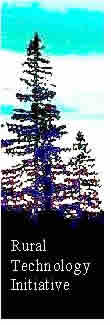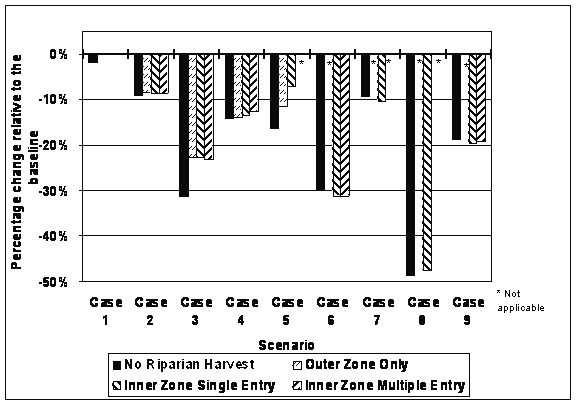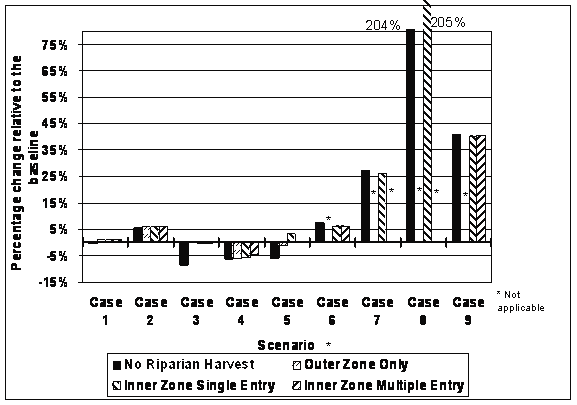 |
 |
 |
 |


Fact Sheet #20:
Impacts of the Forest and Fish Rules on Non-Industrial Private Forest
landowners in north eastern Washington: Some key consequences from riparian
zone case study evaluation.
|
Revised March, 2003 By Elaine Oneil
The Forest and Fish Rules (FFR) restrict timber harvest on private lands east of the Cascades in a three-zone riparian buffer along any potentially fish-bearing streams. Total buffer widths vary from 75-130 feet wide by site quality and stream width, with larger streams and higher sites given wider buffers. No harvest is allowed in the "core zone" closest to the stream. Harvest is permitted in the middle or "inner zone" if the forest condition meets a dual criteria for minimum basal area and tree count of a specified diameter size. Harvest is also allowed in the "outer zone" as long as a stream-adjacent parallel road is not present. Under the FFR, basal area retention requirements vary along an elevation gradient with higher levels of retention required at higher elevations and on higher site classes. Stream classification is based on the width, gradient, and flow metrics of the stream as well as basin characteristics. Presence or absence of any particular species of fish is not considered in stream classification. For each case study, treatment scenarios were simulated over a 90-year growth period using USDA Forest Service developed Forest Vegetation Simulator (FVS) growth models and the Landscape Management System (LMS) forestry software developed at the University of Washington's Silviculture Laboratory. Simulations of multiple harvest options and treatment regimes for both upland and riparian management units for each case study were compared to assess potential economic outcomes. Upland simulations were developed based on typical eastside management regimes that emphasize 20-30 year harvest re-entry periods. In most cases, successive harvests produced continuously lower harvestable volumes until such time as a final 'shelterwood' harvest was simulated to permit the re-establishment of shade intolerant seral species in the understory layer. While each simulation is unique to address the specific stand conditions currently present, all are predicated on maintaining a relatively consistent cash flow over time as well as meeting biological and legislative requirements for site occupancy, tree growth, and harvest adjacency issues. Because of negative harvest values for small diameter trees and narrow margins of return, scenarios did not remove the accumulation of small growth within riparian areas. This outcome may have undesirable consequences as Camp (1995) found that accumulations of forest fuels in riparian reserves could result in high risk to habitat qualities from fires and insect and disease vectors. A baseline performance scenario was created that simulated management
requirements for the permanent rules that were in place prior to
enactment of the Forest and Fish Rules. By comparing the FFR to
a 'baseline' of the "permanent rules" in effect immediately
prior to June 2001, a measure of the incremental impact of the new
legislation is possible. "Emergency rules" in effect immediately
prior to June 2001 were not modeled in this analysis. Four riparian
area management scenarios were evaluated under the FFR rules that
included a no harvest option, harvest in the outer zone only, a
single harvest entry in the inner zone, and multiple harvest entries
in the inner zone. Riparian area treatment simulations were designed
to coincide temporally with adjacent upland harvest simulations.
Economic Consequences
Economic losses greater than 20% of the baseline occurred in situations where streams were reclassified from non-fish bearing to fish bearing as in case 3, where there are significant water resources found within the study area as in case 6 or where the ratio of riparian to upland holding was very high as in case 8. Size of landholding was not a proxy for impact as case 6 is the largest in the study at 825 acres and case 3 is the smallest at 20 acres. In case 1 an inadequate number of trees > 10" dbh restricted harvest to approximately the same degree under the baseline and FFR rules, resulting in a 0-2% variation in economic value under either rule depending on harvest scenario. In cases 6, 7, 8 and 9, no outer zone simulations were required because soil capability classes exempted these areas from the rules. In cases 5, 7 and 8, the multiple harvest entry scenario was not possible because the stands did not produce sufficient volume and basal area to permit a viable second entry over the 90-year simulation period. In many instances economic losses can become gains if the landowner
qualifies for and chooses to participate in a state funded compensation
program called the Forest Riparian Easement Program (FREP), as indicated
by the positive values noted in Figure 2. These positive
values occur in 7 of 9 cases, because taking an easement on all
riparian areas increases the economic return to landowners over
what they could have obtained under baseline rules.
These gains arise because landowners would be compensated for the value of all timber they are required to leave under the FFR, whereas under baseline rules that included stream protection and shade criteria, no such compensation had been available. This finding is consistent with the results of a recent Department of Revenue (DOR) study that compares the value of riparian leave trees to the forest excise tax credit. (Rice et al., 2002) The DOR report indicated that the value of timber left in riparian areas in eastern Washington was 65% attributable to requirements under the baseline rules and only 35% attributable to requirements under the FFR. These eastern Washington harvester results include large and small holdings. If only small harvesters are considered, riparian timber values accounted for 49% the value of residual timber under the old rules. The small harvester figure applies to all Washington regions, not just eastern Washington. Thus, while impacts to small landowners in eastern Washington cannot be definitively determined from these results, the implication is that somewhere between 49% and 65% of the value of riparian timber that must be left under the FFR, was also required to be left under the baseline. Payment for this timber, particularly in high impact over-ride situations, accounts for the positive economic results under the FREP for the majority of the case studies. As with the economic outcomes under the FFR, with the FREP there
is also considerable variability in economic impact among landowners
in eastern Washington. This variability is illustrated in case 7
where baseline harvest was prohibited because of inadequate tree
count as in case 1. However, because of differences in tree sizes
between the two cases, for case 7 the relative economic benefit
of the FREP is substantial. Positive values under the 'No Riparian
Harvest' scenario arise when harvest activities at a normal re-entry
period in adjacent upland Under the FREP landowners are offered compensation for a percentage of the stumpage value of trees left uncut to meet FFR requirements in exchange for entering into a 50-year commitment or "easement" to leave these trees unharvested. Optimal scenarios vary depending on the landowner's choice of participation in the FRE Program and the site and stand characteristics within riparian areas. Values in Table 1 identify the best economic outcomes by case under FFR, both with and without enrolling the lands in the FREP.
Despite the gains that can accrue under the FREP, a review of Forest Practices Applications to the DNR would appear to indicate that a majority of small forest landowners may be choosing to forego any riparian harvest while also foregoing participation in FREP. In 5 of 9 of the cases in this study, opting for complete avoidance of riparian harvest resulted in the greatest economic loss for the landowner. For more information on the FREP contact the Small Forest Landowner Office (SFLO) of the Washington State Department of Natural Resources (DNR) at their web site, http://www.wa.gov/dnr/sflo/frep/.
Conclusions While the FREP may provide some forest landowners with economic relief, sufficient funding for this program is not secure (See Factsheet #2). Some landowners report that in spite of FREP compensation benefits, they are unwilling to grant a 50-year state-held covenant on their forestland. In addition, the FREP does not provide incentive for stewardship activities such as removal of excessive fuel loads or restoration of early seral habitat types. In cases where the biological intent of the FFR cannot be met with the current FFR parameters, the adoption of alternate plans that address stewardship values while balancing economic return may be an optimal solution.
|





